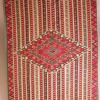2008.74.1
This Saltillo sarape is of fine quality. It can be described as a Classic Saltillo Sarape: the center is composed of a concentric diamond; the field is a vertical mosaic; and the border is a diamond spot repeat in a zig-zag pattern. The colors are red (which has been tested and is cochineal), pink, white, green, black, yellow, blue and light blue. The long, vertical edges have been bound in a green tape that has been stitched in place. The stitching attaching this binding varies considerably from small and medium-sized running stitches in green, to small white running stitches, to large light blue running stitches, to red whip stitches. The slit in the middle of the diamond center of the sarape is also bound in green tape, but a slightly lighter color of green. (This tape is similar to binding that would have been used at the hem of women's skirts in the middle/toward end of the 19th century.) The tape is stitched to the sarape with a running stitch in thread that matches the color of the tape. The bound slit is then stitched together in a large, bold whip stitches using green thread. A bow is at one end of the stitched slit. Also a series of metal "eyes" or eylets, are also sticthed along the edge of the slit.(The warp threads are visible in some areas of the spotted zig-zag border.) There are vestiges of macrame fringe made from the natural colored cotton warps at either end of the sarape.
Saltillo, Mexico is know to have been a market place. Because finely woven sarapes were sold in Saltillo, although they could have been woven in one of several other communities in the general area, good sarapes of this type are generally called Saltillo sarapes.The Saltillo sarape is a garment, a wearing blanket. Sometimes there is a hole in the center (as in this sarape--however, it has been stitched shut) and the garment is pulled over the head, similar to a poncho; another way of wearing it would be to drape it around the shoulders.The cochineal dye is technically and historically very important. Red dye was the stuff of legends; cities such as Lucca and Venice were noted for their textile industries in the 14th and 15th centuries. For centuries after the discovery of New Spain, Spain kept careful guard over the cochineal industry. (Cochineal is made of the dried bodies of female Dactylopius coccus. These small insects live on the nopal--prickly pear cactus.) The red dye produced by cochineal is exceptional. Colonies of nopal thrive in Mexico. Although other countires tried to steal and smuggle the host nopal and the tiny insects out of Mexico, they didn't meet with lasting success.
Used: adult ~ male | Californio | Mexican







